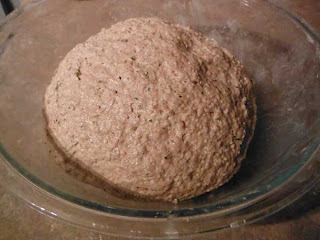Whole Wheat, Hemp and 8-grain Bread
Wasted bread
There is a report out recently in Canada that more than half of our food is wasted. It is thrown away. This is wrong because there is a public cost to throwing food away, and it is particularly sad because so many people in the world go hungry. This, at a time when obesity in North America is on the rise, and donations to food banks are dwindling in a time of increased need.
Researchers say that one reason we are filling dumpsters and landfills with food is because consumers are buying too much food on sale, and then they toss it before they can use it, which makes no economic sense. They urge new regulations on labeling: instead of "Best before" dates, they recommend "Use by" dates. They urge greater awareness by consumers about food distribution. They urge cities to start collecting and composting organic waste. They want to change our attitudes and our methods of food distribution, because it is so utterly wasteful at every step in the chain.
Restaurants are also to blame, and are a good example of our careless attitude toward food. Restaurants throw food away, because they are trying to give people value for their money by giving over-large portions. Often, fast-food outlets will give bread to their patrons along with fries, when the extra starch is not necessary or requested. In this case, it is usually the bread that is wasted.
In my recent reading of articles to learn about the staling of bread (which I hope to blog about some day), I turned up an interesting statistic given by Gomez (Gomez, M et. al. "Effect of Fermentation conditions on bread staling kinetics (2008) Eur Food Res Technol 226 pp 1379-1387) who said, "It is thought that 3% of the production of bread is returned for problems of staling in the shape of unsaleable bread." I suspect that the amount that gets tossed, and not returned, by consumers is far higher. But curiously, the report did not specifically mention the waste of bread.
I usually eat all my bread, and what I don't eat before it stales, I give to the chickens. I have seen recipes that use altus, or old bread, but I have never had the opportunity to use my stale bread in this way yet. With my bread, I might consider it. But with the present methods of distribution of food, who would consider adding a loaf of stale store-bought white bread to their own home-made bread, to prevent wasting it?
Today's bread
My bread today is made with whole wheat, cracked hemp and an 8-grain mixture.
Ingredients
- 800g ww flour
- 200g cracked hemp
- 200g 8-grain mix
- 50g wheat germ
- 452g sourdough starter
- 750g water
- 20g salt
Here's an explanation of the odd size of the starter in the above recipe. This began as a mixture of 178g starter at 100%, but 12 hours previous to the use in this bread, it was mixed with whole wheat flour and a tiny bit of water, enough to make a fairly stiff dough. if I would guess, I would estimate that the amounts in this starter were:
- 178g backslop starter @100% hydration
- 200g whole wheat flour
- 74g water
Many of my 100% hydrated starters sink in water after a minute or two. But this ~56% hydrated mixture ( 289g ww, 163g H20) had fermented by the time of use, and floated easily in the water, without any sign of taking on water and sinking, or falling apart. To me, this simply means that there was a fair amount of gas in the mixture, and cells of dough tight enough to keep the gas intact. It took some effort to break up this stiff starter for use in the dough. I did it by hand, but was considering that a blender or food processor might be a more efficient method.
Results
This is a tasty loaf: the hemp keeps the dough hydrated, and the 8-grain mix makes it nutty and slightly crunchy, especially at the crust.
Needless to say, I gave away one of these loaves, and ate all of the other loaf, wasting none of it.
Needless to say, I gave away one of these loaves, and ate all of the other loaf, wasting none of it.
Notes to Myself
- Compared to Canadians, U.S. consumers throw out a mere 40% of their food -- still pretty bad.
- This is a loaf I would repeat sometime. It seems to be a good combination of grains.
- I think I might go slightly higher on the hydration - next time, perhaps 770g of water for this amount of grains/flours (or perhaps what appeared to be a less hydrated dough is merely an effect of using more starter?)
- How would blending of sourdough starter in a food processor affect the cells of the yeast, including the budding of daughter cells? Would it break them up, and destroy some of the cells?











No comments:
Post a Comment